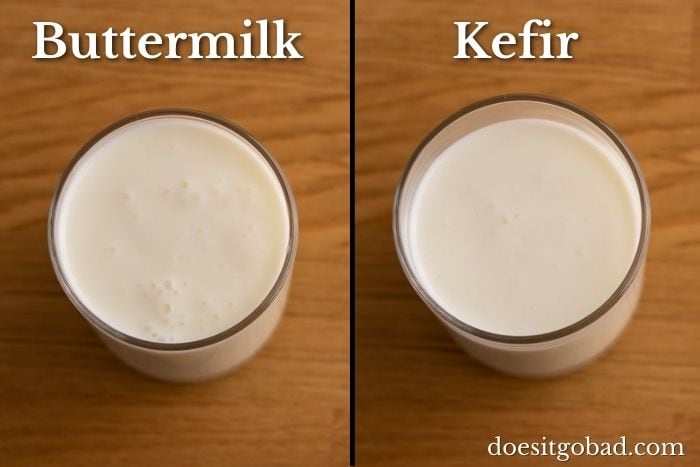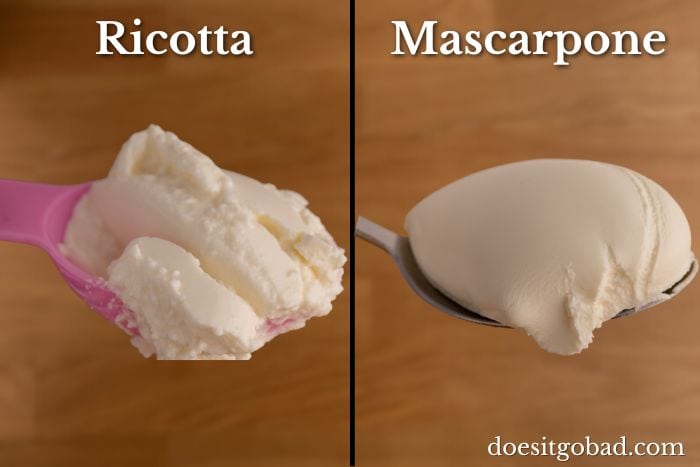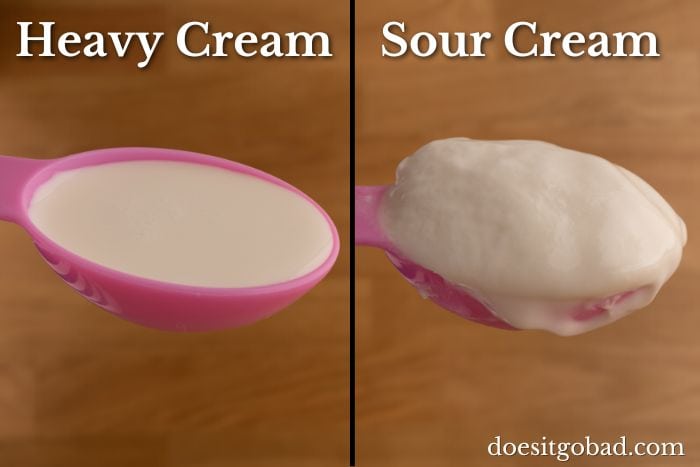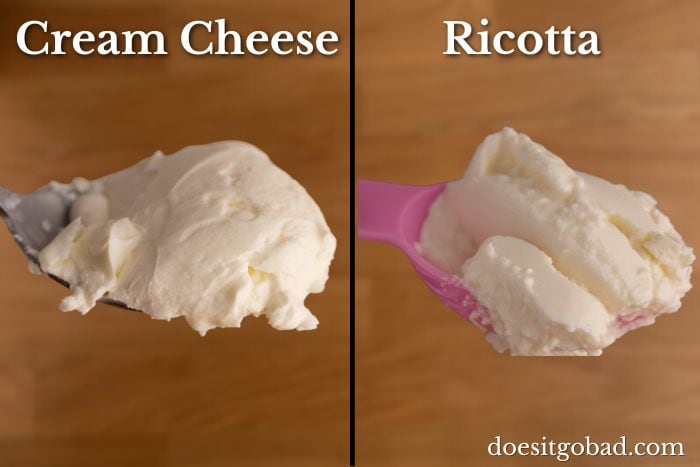Sour Cream vs. Cream Cheese: Differences and When to Sub
While sour cream is a variety of cream and cream cheese is, as the name implies, a cheese, both dairy products have quite a lot in common. And quite often, you can substitute one with the other.
Cream cheese is much thicker than sour cream, and it has a mild, somewhat tangy taste.
Sour cream, on the other hand, tastes sour and tangy and is like a thick yogurt in terms of texture.
Those make the products similar, but definitely not direct substitutes. Subbing one with the other only works well only in specific settings.
Interested in learning more about the similarities, differences, and when substituting makes sense?
Read on.
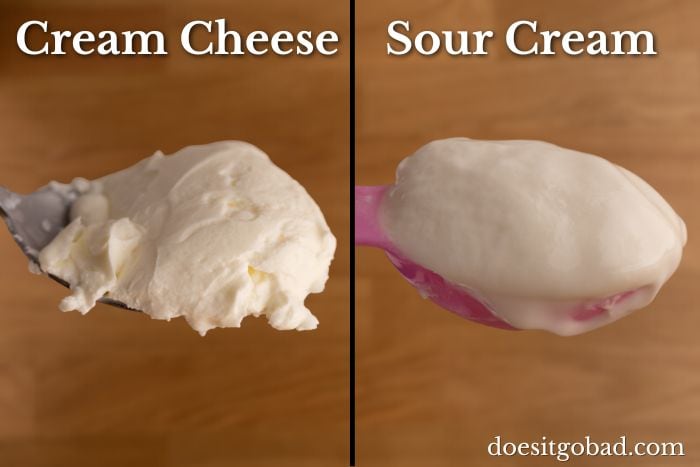
When to Substitute
Cream cheese and sour cream aren’t direct substitutes, but swapping works well in many contexts.
It’s easier to sub cream cheese for sour cream because all you need to do is to thin it down with water. And you can add some lemon juice to adjust the taste.
It’s a bit more difficult the other way around, as there’s no easy way to make sour cream nice and firm and remove its tang to make it taste more like cream cheese. But in some dishes, the taste difference isn’t a huge issue, and you can adjust the amounts of other ingredients to fix the texture.
That’s the high-level overview. Next, let’s get into the details.
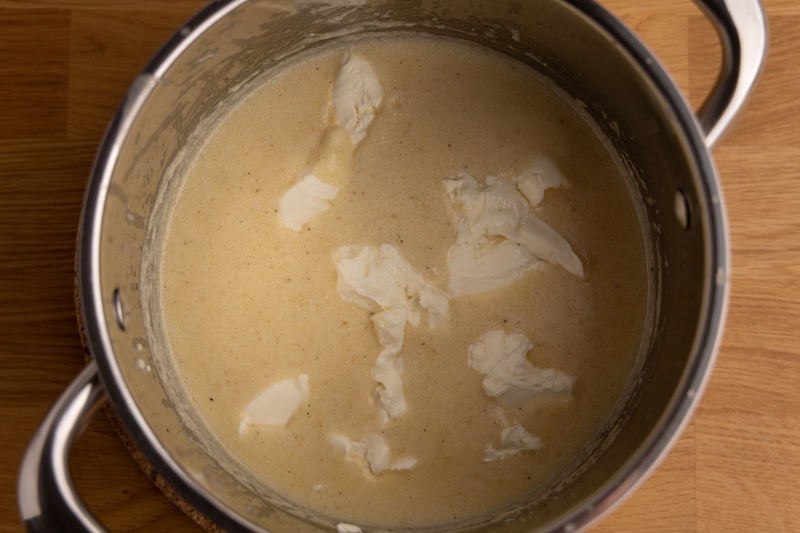
Can I Use Cream Cheese Instead of Sour Cream?
You can substitute cream cheese for sour cream in most cooked or baked dishes. To do so, mix in one tablespoon of milk or water per cup of cream cheese to adjust the texture. Then, if sourness and tang are essential to the dish you’re cooking, add a squeeze of lemon or lime juice.
(A couple of drops of white vinegar or apple cider vinegar should work in a pinch.)
After making the above mixture, taste it and add more water or acid if necessary. You can easily make it as thin or sour as you need by adding those two ingredients.
As I mentioned, that substitution works well in cooked and baked recipes (think pancakes, soups, casseroles, or cakes), as these are usually quite forgiving. The taste and texture of the sour cream don’t (typically) make or break those dishes.
But that sub might not work as well in salads, toppings, and other recipes that aren’t cooked. You can use it in a pinch when making a relaxed weeknight dinner, but unless tested in the specific recipe, I wouldn’t use it for a family gathering dinner.
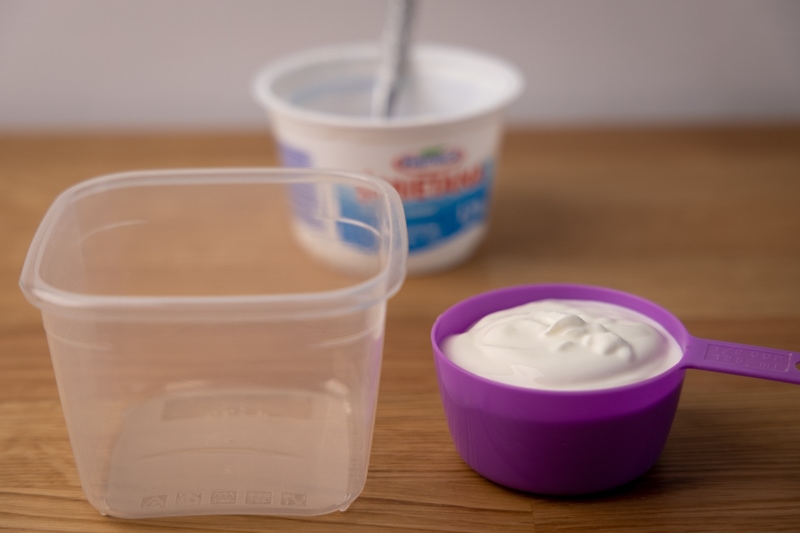
Can I Substitute Sour Cream for Cream Cheese?
You can use sour cream instead of cream cheese in equal amounts, but that’s not a direct substitution.
Sour cream will make whatever you’re cooking more tangy and zingy and make the texture noticeably thinner. Because of that, it works best in cooked and baked dishes.
When using this substitution, you might need to adjust the amounts of other ingredients to achieve the desired texture.
For instance, if you’re making pancake batter, you might need to lower the amount of milk or water used. Or, when making muffins, you might need to add more flour to get the muffin batter to where it needs to be consistency-wise.
As usual with substitutions, the more familiar you are with whatever you’re cooking, the higher the chance subbing will go just fine. And if you’re cooking the dish for the first time and aren’t that confident in the kitchen, I suggest making something else.
Or, instead of subbing sour cream, search for a recipe that uses that ingredient natively, and use it instead.
For instance, if you want to make cream cheese muffins and don’t have cream cheese on hand, search for “sour cream muffins.” Chances are you’ll find a recipe you have all the ingredients for.
If you’re looking for better alternatives, ricotta is a decent cream cheese alternative in many recipes, and if you’re making a sweet dish, you can often use mascarpone instead of cream cheese.
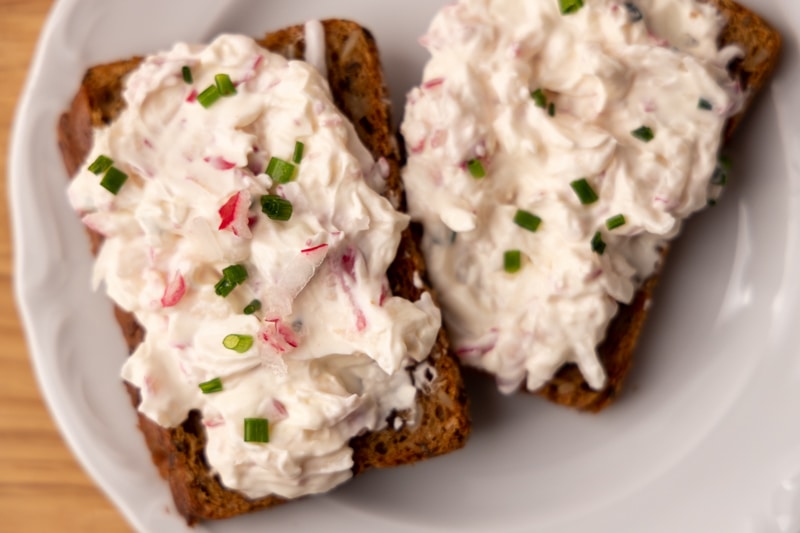
Sour Cream vs. Cream Cheese: Differences and Similarities
Sour cream and cream cheese have many differences, but there are also enough similarities to make subbing one with the other in specific contexts possible.
Below, I divided all the information into a few categories so that it’s easier for you to find what you’re interested in most.
Taste and Texture
The taste and texture are where the differences between sour cream and cream cheese are the most obvious. Here’s how the two compare:
Cream cheese is creamy, spreadable, and has a slightly tangy but mild taste. It also makes a great base for flavoring. All you need to do is mix in some herbs or aromatics. Or buy a flavored one.
On the other hand, sour cream has a thinner, spoonable texture and rocks its signature tangy and somewhat sour flavor.
Both products are close to each other, but you definitely wouldn’t mistake one for the other.
Because of those differences, you can sometimes use sour cream instead of cream cheese (and vice versa), but that usually calls for some other adjustments to get things right.
Uses
| Sour Cream | Cream Cheese |
|---|---|
| Topping pies and cakes | Slathering on bread, rolls, bagels, toast, etc. |
| Dipping sauces and salad dressings | Creamy salads, spreads, and dips |
| Making things more creamy (soups, mashed potatoes, etc.) | Cake icing and frosting |
| Cooked and baked goods like muffins, scones, pancakes, and cookies | Adding richness and creaminess to soups |
| Casseroles | Casseroles |
While sour cream and cream cheese are often used in similar recipes (think sauces, dressings, dips, and pie and cake toppings), they aren’t necessarily used to achieve the same result.
Cream cheese is often used to make a dish more creamy, be it a soup, salad, or a spread, but it doesn’t offer much in terms of flavor. Sour cream can also add richness and texture to some extent, but it’s also a great source of tanginess.
Because of that, both products are often used in combination. Cream cheese adds a lot of richness and creaminess, while sour cream adds some sourness and tang without diluting everything too much.
That said, cream cheese is most often used as a sandwich spread. You can slather it on bread, bagels, toasts, flatbreads, or any other piece of bread. And if you’re feeling fancy, you can mix in some herbs or aromatics to get different flavors.
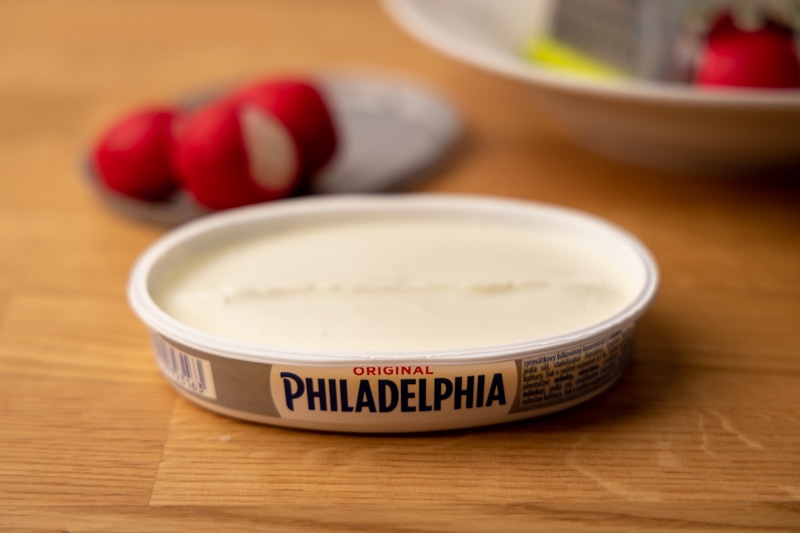
And sour cream will never replace cream cheese in that use case.
On the other hand, cream cheese isn’t particularly popular in baking, unlike sour cream, which is an essential ingredient in hundreds of muffins, cupcakes, and pancake recipes.
(Sure, there’s cream cheese frosting, but that’s just a notable exception.)
That’s the way things are because the taste and texture of sour cream work well in baked goods, and that of cream cheese doesn’t fit the bill nearly as well.
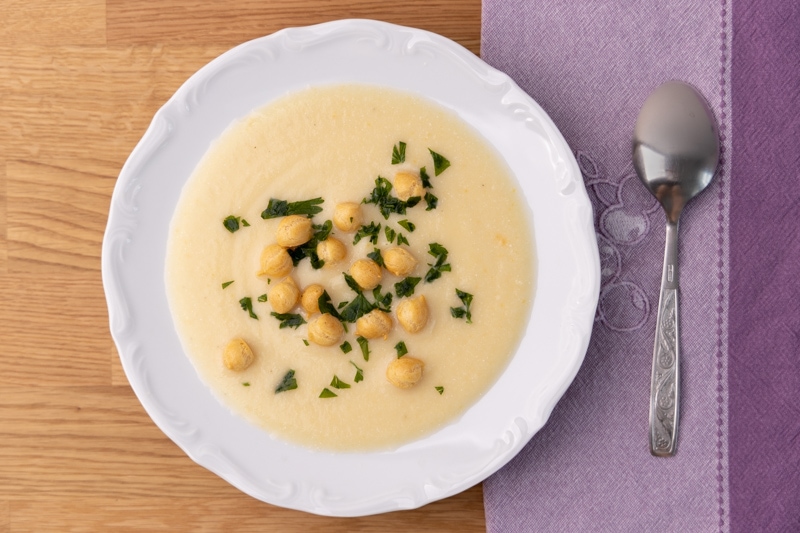
Nutrition
The macronutrient profiles of sour cream and cream cheese are noticeably different, except for the amount of carbohydrates. Here’s what they look like (per 100g):
| (per 100g) | Sour cream [source] | Cream cheese [source] |
|---|---|---|
| Energy | 198 kcal | 343 kcal |
| Protein | 2.44g | 5.79g |
| Fat | 19.4g | 33.5g |
| Carbohydrates | 4.63g | 4.56g |
The most important nutritional difference between sour cream and cream cheese is the amount of fat.
Sour cream typically has 12 to 20 percent fat, depending on the brand and variety you buy, while cream cheese has at least 33 percent. That makes the latter a much more calorie-dense product.
That said, you can also find light cream cheese that has about half of the usual fat content. That variety is comparable to sour cream in terms of calories and overall macronutrient profile.
(Of course, you can also find a fat-reduced version of sour cream if you want to go that route.)
Overall, cream cheese is a much more calorie-dense dairy product. So if you’re watching your caloric intake, limiting it and using sour cream whenever possible seems like a smart thing to do.
That’s not to say that sour cream is a low-calorie product. It also packs a fair amount of calories, and it’s not something to go overboard on (say, with your mashed potatoes) if you’re watching your calories.
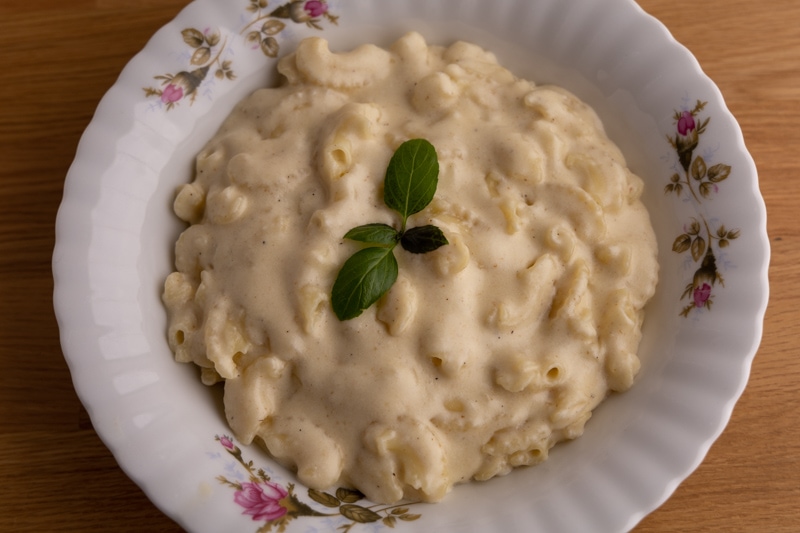
Production
The production processes of cream cheese and sour cream are actually quite alike.
For sour cream, everything starts with regular cream, while cream cheese starts with either cream or a mix of cream and milk.
Then, lactic acid bacteria (not necessarily the same exact strain) are added to the mixture. Those bacteria make sour cream taste somewhat sour and tangy and make cream cheese slightly tangy.
That’s the moment when both products go their way.
In making cream cheese, the milk and cream mix is fermented, which makes it thicker. Then it’s run through a separator that separates the mixture into curd and whey. The curd is then collected, stabilizers are added to maintain the texture, and sometimes nitrogen is mixed in to add volume and make the cream cheese spreadable.
When making sour cream, the fermentation takes longer, and it ends up with a nicely thickened cream that just needs to be packaged and refrigerated.
Of course, knowing that cream cheese has much more fat than sour cream, it’s pretty obvious that it starts out with cream that’s higher in fat than the one used for sour cream.
The Bottom Line
Sour cream and cream cheese have some similarities but are also quite different.
Both are made from cream and fermented using lactic acid bacteria, but that’s where the similarities end.
Cream cheese has much more fat, is spreadable, and tastes pretty mild. Sour cream, on the other hand, has less fat and is noticeably thinner than cream cheese (yet still spoonable). It also offers its signature tang and a bit of sourness, which nicely compliments many dishes.
Cream cheese is a popular sandwich spread, and since it has a pretty mild and neutral flavor, it’s great for experimenting with various herbs and aromatics to build various flavors.
Its other uses, such as making creamy salads, spreads, dips, cake icing, and the like, are kind of secondary to its main use.
Sour cream is much more versatile in this manner, and there’s no “default” use of this dairy product.
Rotten Records: Share Your Snap!
Caught some food past its prime? Upload your photo to “Rotten Records” and help others spot the signs of spoilage. Every image makes our food community safer and more informed!
